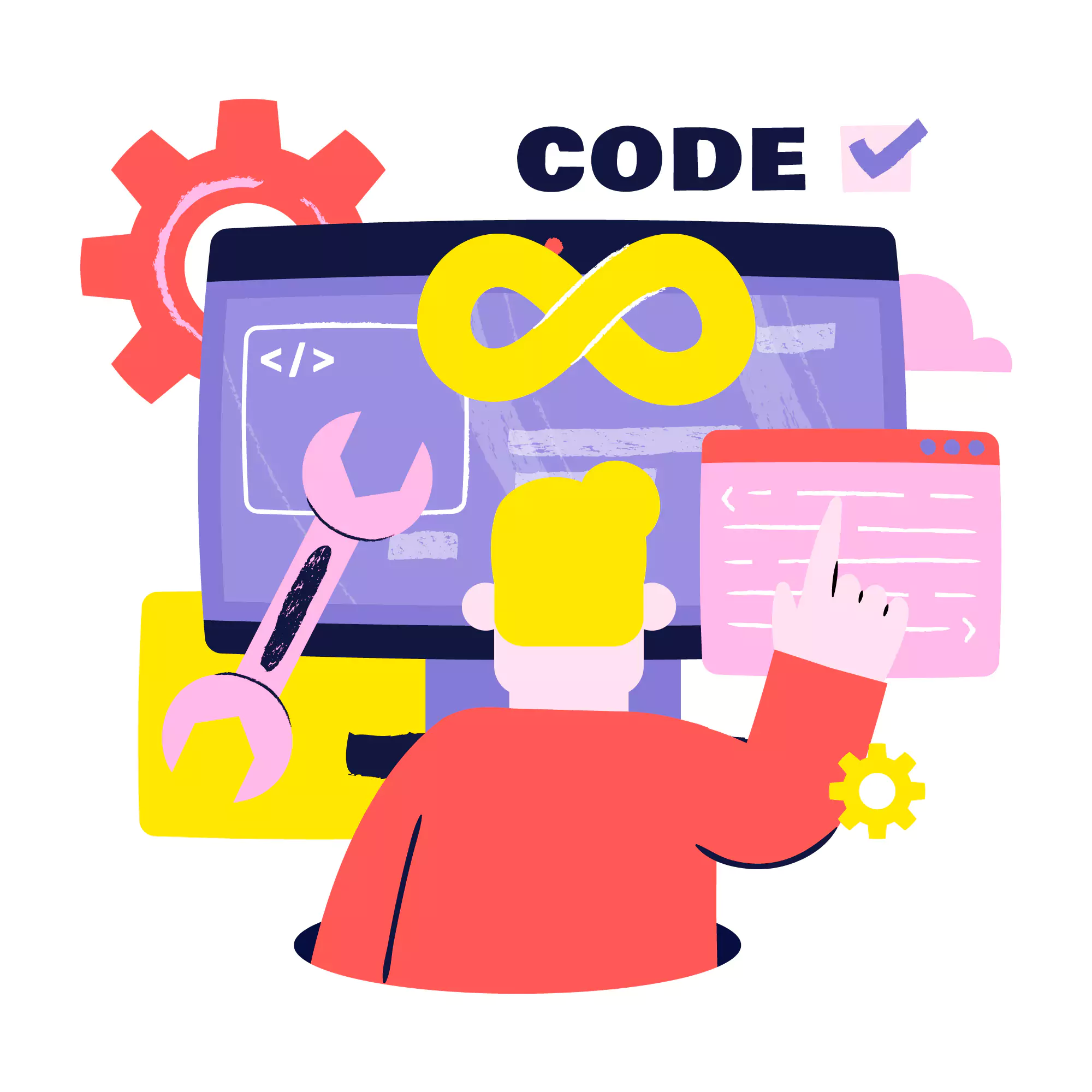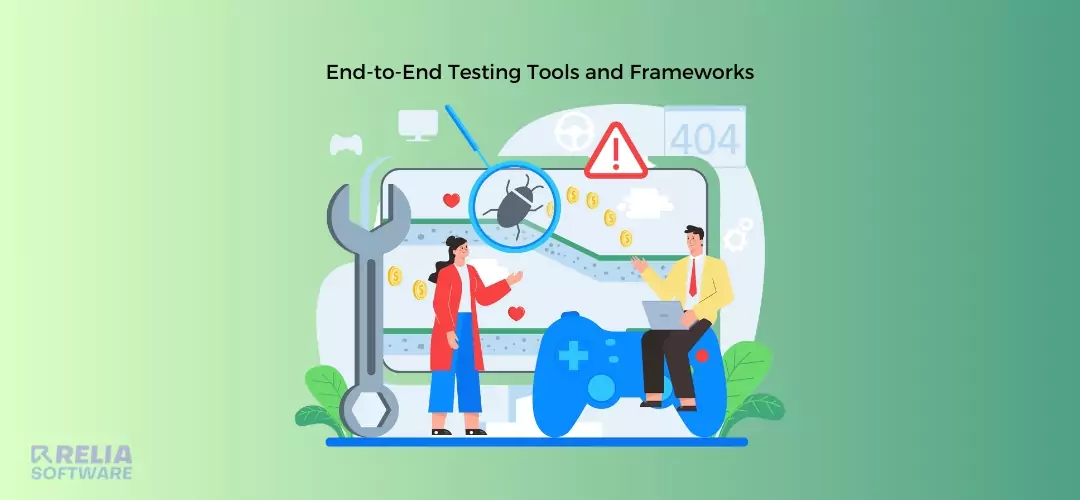Testing the application's components' optimal performance reveals hidden problems and faults. No one enjoys being renowned for mistakes and carelessness, including testers. Therefore, the testers can also monitor user responses to software features to minimize mistakes.
This article explains the features and benefits of end-to-end testing tools and frameworks. You can test your software using the procedure. Let’s find out!
>> Read more: Manual Testing vs Automation Testing: Which is Better?
What are End-to-End Testing Tools?
Cloud-based end-to-end testing solutions let teams test software applications' performance and functionality. These tools enable you to generate real-life test scenarios to identify and fix user concerns.
Entire application workflows are tested in genuine user scenarios. Important elements of an ideal end-to-end testing software include:
-
User interface: A simple, well-organized interface
-
Usability: Let any team member streamline their operations easily.
-
Code-free test execution: Non-programmers should write, execute, and manage test cases easily
-
Cross-platform testing: Test your software on several platforms and devices.
-
Simple codebase: Tools with a codebase should assist developers in interfacing with diverse frameworks and libraries.
-
Value: Should provide all necessary features at a reasonable price.

Three Types of Design Framework for End-to-end Testing
The three components of the end-to-end testing design framework are developing user functions, conditions, and test cases. Let's quickly review them.
Create user functions
Identify all software and subsystem features. Note the input, output, action, and linkages. Determine if user functions are independent or reusable. For example, user functions for transferring money from your bank account to a third-party subsystem include:
1. Log into the banking app.
2. Check account balance
3. Transfer funds to third-party subsystem
4. Check the post-transfer balance.
5. System logout
>> Read more:
- Why You Must Embrace Digital Transformation in Banking and Financial Services?
- The Importance Of Digital Transformation in Healthcare
- How Digital Technology Is Changing The Real Estate Industry?
Build conditions
Set up a set of conditions for each user function before you start building conditions based on them. This could include things like time, data conditions, and other things that affect how the user works. For instance, verify login circumstances check for:
-
Invalid username and password
-
Password strength
-
Username and password validity
-
Error messages
Create test cases
Create user function-specific test cases and scenarios. When you're writing test cases for end-to-end testing, remember these things:
-
Make a lot of test cases to make sure that all of the user services work.
-
Each condition should have at least one different test case.
For instance, test situations in banking include:
-
Transfer funds locally
-
Use bank data for eCommerce transactions
-
Pay overseas banks via the banking app
>> Read more:
- Top 6 Automation Testing Tools for Businesses in 2023
- Top 10 Automated Code Review Tools For Developers

10 Best End-to-End Testing Tools and Frameworks
Katalon
The end-to-end testing on the Katalon Platform automates UI and API tests with AI-powered features, simplifying and expanding test coverage while lowering cost and effort.
Katalon lets QA teams write, execute, maintain, and evaluate web, mobile, and desktop automated tests on many environments across one platform.
The feature of Recorder and Script mode lets beginners record and playback UI actions, drag-and-drop keywords, and import developer code. Expert programmers can conduct development testing by scripting complex scenarios in Java/Groovy or creating custom keywords.
Highlights of the feature:
-
Compatibility testing: local and cloud browsers, devices, and operating systems are available for parallel execution of cross-platform API, end-to-end, and regression test suites.
-
Simple upkeep: An object repository is included for storing and accessing all of your UI elements, objects, and locators. When the application's user interface changes, you may easily update the tests.
-
Traceability of requirements: Jira, qTest, and Xray native integrations.
-
API testing using REST, GraphQL, and SOAP: REST, SOAP/1.1, and SOAP/1.2 requests are supported. Swagger, Postman, and WSDL can all be used to import tests.
Autify
Autify automates online and mobile app testing. Recording application interactions using its Chrome extension lets you automate end-to-end testing and execute them on Windows, Linux, Mac, and a variety of web and mobile browsers. Features include:
-
Smart Test Automation uses artificial intelligence and machine learning to find changes in the user interface automatically and make changes to the test cases to match.
-
Visual Text Editor: To make tests, click and drag things on the screen.
-
CI/CD tools like CircleCI, Jenkins, and Gitlab can be used together with this app.
-
Analysis of Test Results: Test reports and data, with videos and pictures
LambdaTest
LambdaTest is an internet-based testing across browsers tool for end-to-end web application testing. You may test your web application's performance, user experience, and performance on over 2,000 actual browsers and operating systems.
Highlights of the feature:
-
Website responsiveness testing: LT Browser tests webpages on major devices and viewports.
-
Cross-browser visual testing: Web page full-page screenshots made automatically
-
Locally hosted website testing: Page validation with Lambda Tunnel—an SSH integration tunnel
TestComplete
TestComplete by SmartBear is a strong automatic testing tool that makes UI tests for desktop and web apps and runs them. Tests can be recorded, scripted, or made by hand using keyword-driven operations. They can then be played back automatically and errors can be noted.
Highlights of the feature:
-
Easy testing: TestComplete makes it easier to make tests without slowing down or restricting your options. It is flexible and can automatically test UI on desktops, the web, and mobile devices (Android and iOS). Plus, it gives you options because application tests can be made by hand, automatically, or by recording them using keyword-driven or data-driven features.
-
Flexible testing tools and programs: TestComplete works with many tools and programs, including Jenkins, Git, Atlassian Jira, Atlassian Bamboo, Subversion, and Mozilla Bugzilla, because it is based on an open COM design.
-
Clean user interface: It has a clean user interface and can be used by a lot of people. There are more tools than just testing, QA, and task management. These include performance control, workflow management, test case tracking, push notifications, and ticket management.
testRigor
testRigor is a popular end-to-end testing framework that helps manual testers automate tests quickly. It lets testers easily write, change, and update complicated tests and quickly increase test coverage.
testRigor lets you perform testing with simple, plain commands, which makes it perfect for manual QA testers who don't know much about programming. Its AI-powered automation tool can make tests more thorough with very little work. TestRigor also lets you make your own test cases for more complicated situations.
Highlights of features:
-
The ability to make tests that work like real people would interact with your app.
-
Makes multi-platform tests for web, native, and mixed mobile apps without using code.
-
Works with test managing cases tools without any problems.
-
Builds strong end-to-end functional tests.
-
Use basic English to automate tests without code.
-
Writes code-less cross-platform web, native and hybrid tests.
-
Integration with all test case management systems is seamless.
testRigor is perfect for development teams that wish to rapidly enhance test automation coverage while lowering maintenance costs.
Selenium
Selenium is a well-known tool for end-to-end testing that helps testers run tests in different browsers. The project is open-source and makes practical tests for the browser. Selenium can work on all browsers that accept JavaScript because it was built with JavaScript. It makes HTML manipulation easy, letting you personalize tests.
Highlights of features:
-
Quick and easy to start testing web apps
-
Works with many apps, such as Chrome, Firefox, Safari, and Opera
-
Works with a lot of different running systems, like Windows, Mac, Linux, Unix, and more.
-
It works with many computer programming languages, such as Python, Java, Perl, and Ruby.
Cypress
Cypress is a well-known JavaScript system for end-to-end testing. It is a front-end automated testing tool for web app UI debugging. Cypress, using Mocha, focuses on Selenium waits and timing concerns. Cypress has built-in debugging and automated retries and waits.
Unlike other end-to-end testing frameworks that can work with more than one language, this one can only work with JavaScript.
Highlights of features:
-
Automatic waits for inputs and assertions without async/await functions.
-
Compatible with Firefox, Edge, and Electron.
-
Dashboard: parallel, cross-platform, load-balancing, quality insights
-
GitHub Actions, GitLab CI, CircleCI, Bitbucket Pipelines, AWS CodeBuild CI/CD integration.
-
Photos and videos: examine prior DOM states to determine what went wrong
-
Setting up tests is simple and quick in just 60 seconds,
-
It lets you see tests run in real-time while you work on your apps.
-
Works with many apps, such as Chrome, Firefox, Edge, and Webkit
TestCafe
When it comes to testing web-based apps, TestCafe is one of the best open-source end-to-end testing tools. Even though TestCafe is a fairly new platform, it has grown and added many useful features over the years.
Highlights of features:
-
It's free to use and is shared under the MIT license.
-
People mostly use it to test the whole app, but they can also use it to test APIs.
-
Since the tests run in a browser, they are faster than tests that use other tools.
-
It helps testers see what each action does on the browser, which makes debugging easy.
BugBug
BugBug is a program for automated testing that lets you run manual regression tests. This makes it easy for your team to fix bugs in your web applications. You can also do integration testing with this tool, which lets you run tests from your ongoing development pipeline.
BugBug is a codeless test platform, which means that no one on your team needs to know how to code. You and your team can check the data of your web and mobile apps in real-time to make sure they are working right. You can now make your testing easier for both functional testing and speed testing.
Highlights of features:
-
Record and execute tests as though users were there,
-
Group and reuse steps for faster test creation and editing
-
Self-healing testing—application updates do not affect your tests.
-
Create a graph model of tests to see what is tested across the project from the start.
-
Support multiple tabs, browser windows, and frames for complicated test scenarios
Nightwatch.JS
Built on top of the Node.js platform, Nightwatch.JS is an open-source tool for automating browsers. It supports many web drivers and frameworks, such as Selenium, ChromeDriver, and FirefoxDriver, and has a simple but powerful syntax for handling end-to-end testing of web applications.
>> Read more: Leading Node.Js Frameworks For Web Application Development
Highlights of the features:
-
Parallel testing lets you run tests at the same time in different environments, which saves time and makes things run more smoothly.
-
Built-in test runner: This is a built-in test runner that lets you run tests and make reports with just one command.
-
Page Object Model: Write tests that are easier to keep up to date and adjust to new systems.
-
Selenium, Sauce Labs, BrowserStack, and other tools can be integrated.

Why Should Choose End-to-End Frameworks?
Every application integrates with external systems and databases. It's obvious that this complicates app workflow. End-to-end testing verifies an application's dependencies' functionality. It also checks if system components are transmitting accurate data.
Backend
End-to-end testing checks app databases and backend code. This is necessary because the program's major functions depend on backend functionality.
Architecture with many levels
End-to-end testing is needed to verify the architecture's functioning and layer interactions in a complex application with a multi-tier workflow.
The distributed environment
SOA and cloud applications need end-to-end testing. Apps with multiple pieces must work together to function.
User experience consistency
Since end-to-end testing includes the front, it ensures the app's user experience works on several devices, platforms, and environments. For instance, end-to-end testing requires cross-browser testing.
>> Read more:
- React Native End-to-End Testing with Detox
- An Ultimate Guide to Different Test Case Design Techniques
Conclusion
End-to-end testing is critical in software development since it tests the user interface and automation technologies cut testing time in half.
This article discussed end-to-end software testing tools and frameworks before release. This testing strategy is essential for application confidence and helping the software development team find bugs.
This post has shown you several common end-to-end testing tools and frameworks. Hope this article is useful for you!
>>> Follow and Contact Relia Software for more information!
- testing
- Mobile App Development

